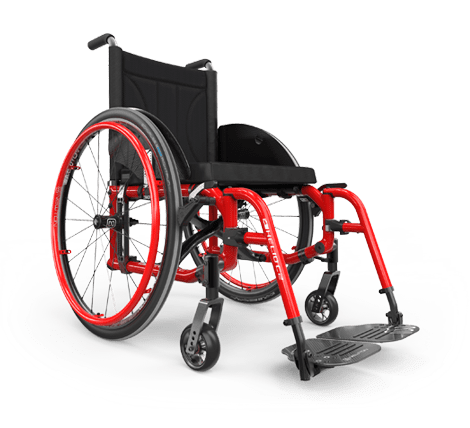Infinite precision adjustability is important because a wheelchair should have the fit of a prosthetic and the performance of a high-end bicycle. Furthermore, a wheelchair user’s parameters for optimal fit and performance are dynamic and likely to change over time for a variety of reasons from improved balance and wheelchair skills, to change in cushion thickness or design. In my 36 years as a T10 para I’ve made many adjustments to fine-tune my chairs, and many adjustments to customer chairs while working as a manufacturer’s rep. Following are examples of how my adjustment parameters changed in my early years of wheeling and how the APEX design makes precision adjustments easy, swift and precise.

The author, Bob Vogel, pictured here with his APEX.
Center of Gravity
When the local DME supplier delivered my first chair, a shiny red, active-lightweight model, the center of gravity was set at a very stable 1” forward of the back post. As my strength, balance and wheelchair skills improved I started moving my center of gravity forward, a little bit at a time until I found the sweet spot for optimal balance, optimal rolling performance and snappy turns--for me this was significantly further forward than what was ideal when I received my chair.
Adjusting the APEX center of gravity is a snap. The laser-etched markings that run the full 6″ length of center of gravity range makes precise fine-tuning center of gravity adjustments quick and easy—significantly easier than relying on a tape measure and sharpie to measure and align adjustment.
Changing the center of gravity also requires readjusting the caster housing angle. This is another adjustment that is quick and precise on the APEX thanks to a Bubble Level incorporated into each caster housing. This enables me to make precise caster alignment in less than sixty seconds per side—much easier and more precise than the usual method of holding a square against the caster housing. Bubble level caster adjustment also comes standard on the Veloce.

Seat dump/Seat Inclination
In my first years as a wheelchair user, I also made significant changes in my seat dump (inclination). My original chair was delivered with 1 ½” of dump. I found my active lifestyle caused me to slide forward on the cushion, something that is annoying and dangerous because sliding creates skin shear which is a known cause of deep tissue pressure sores. After trial and error, I found that 3″ of bucket is the optimal depth for me.
The APEX has laser etchings on the full 4 1/2” range of seat dump adjustability (3 ½ with 20″ wheels and 4″ with 26″ wheels) which enables quick and precise changes in seat dump. Seat dump change also requires backrest angle adjustment, another easy task on the APEX because it has precise settings in 3° increments that go from 80 to 101°.

And like the center of gravity adjustment, any change of seat bucket dump requires front caster housing alignment which is snap with the APEX Bubble Levels.
Other reasons for changing seat bucket dump include switching to a different type of cushion, especially ones that have an ergonomic-dish in the ischial areas. Caveat: changing seat bucket dump can change pressure distribution, whenever I change my seat dump I will sit in the chair for 15 minutes then do a mirror skin check to check for red “hot spots,” and check again after an hour and so on.
Adjustable Rear Wheel Spacing
A very cool and unique adjustment feature on the APEX is adjustable rear wheel spacing. Turning one hex screw enables the rear wheels to move 1 ¼” closer, or further away from the frame, and laser etching makes it easy and precise. I like to run my chair as narrow as possible, but I readjust extra space during the winter months to allow room for a heavy coat. This adjustment also enables extra space for a wheeler that wants to try changing from a narrow tire to a wide-knobby tire.
 Last but not least, in the “ease of APEX adjustability” is my favorite Motion Composites accessory, the Motion Composites Tool Kit which is a 4″ × 2″ box that contains every tool needed for adjusting the APEX. It is available on the APEX order form.
Last but not least, in the “ease of APEX adjustability” is my favorite Motion Composites accessory, the Motion Composites Tool Kit which is a 4″ × 2″ box that contains every tool needed for adjusting the APEX. It is available on the APEX order form.
Parameters for optimal fit and performance are dynamic and unique to each wheelchair user. What is perfect for me may be way too tippy for someone else. Infinite precision adjustability makes fine-tuning the APEX to fit like a prosthetic and perform like a high-end bicycle quick and easy.
Although the above adjustments can be made by experienced wheelchair users, Motion Composites recommends consulting your local wheelchair provider to ensure proper fit and adjustments.










 Last but not least, in the “ease of APEX adjustability” is my favorite Motion Composites accessory, the Motion Composites Tool Kit which is a 4″ × 2″ box that contains every tool needed for adjusting the APEX. It is available on the APEX order form.
Last but not least, in the “ease of APEX adjustability” is my favorite Motion Composites accessory, the Motion Composites Tool Kit which is a 4″ × 2″ box that contains every tool needed for adjusting the APEX. It is available on the APEX order form.